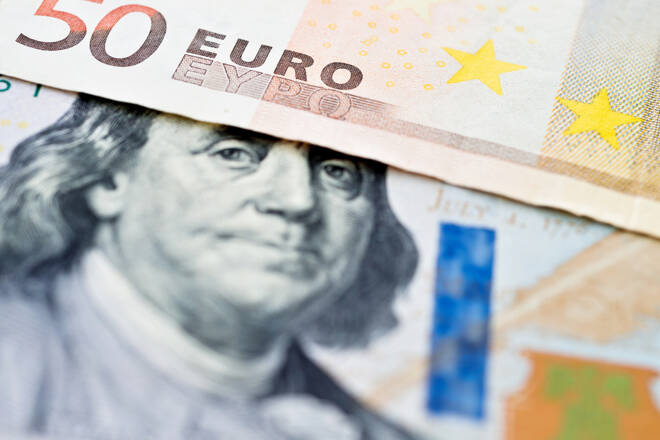Advertisement
Advertisement
EUR/USD Forecast: Navigating Euro’s Path Amid Hawkish Fed Minutes
By:
EUR/USD reacts to US economic indicators, while Eurozone data and potential ECB signals are set to further dictate its course ahead of the Fed minutes.
Highlights
- EUR/USD slipped 0.04% to $1.09014 amid hotter-than-expected US retail data.
- Eurozone economy under the spotlight; key employment and GDP data awaited.
- FOMC minutes: Hawk or Dove, the EUR/USD will listen closely.
The EUR/USD slipped by 0.04% to $1.09014 on Tuesday. After a bullish morning session, the EUR/USD slid to a midday low of $1.08964 before striking an early afternoon high of $1.09524. However, hotter-than-expected US retail sales figures left the EUR/USD in negative territory.
Today, the Eurozone economy is in the spotlight.
Eurozone employment change, second estimate GDP, and industrial production numbers will draw interest. While the ZEW Economic Sentiment Index showed an improving outlook, the jury is out on whether the Eurozone can avoid a further deterioration in the macroeconomic environment.
Economists forecast the Eurozone economy to expand by 0.3% quarter-on-quarter after stalling in the first quarter. Revisions to the first estimate figures will move the dial. However, industrial production will also need consideration, with the weak demand environment suggesting a more marked decline than forecasts. Economists forecast a 0.1% decline in July.
We expect the employment and GDP numbers to have more impact. Employment and consumption are important considerations for the ECB. Deteriorating labor market conditions would signal a slump in consumption and the euro area economy.
An increased contribution from the service sector to the economy has watered down the influence of industrial production numbers. Weak production numbers would align with the latest private sector PMIs.
With the European economic calendar on the busier side, investors should track ECB chatter. However, no ECB Executive Board Members are on the calendar to speak today, leaving commentary with the media to move the dial. Dovish speeches would further pressure the EUR/USD.
The US Session
Housing sector data and industrial production figures for July will be in focus. While the housing sector is a litmus test for the US economy, industrial production numbers will garner interest.
Investors are looking for signs of a deviation from the soft-landing theory.
However, it is worth noting that the industrial production numbers are unlikely to influence the Fed. The manufacturing sector accounts for less than 30% of the US economy and is unlikely to dictate sentiment toward Fed monetary policy. In contrast, a marked deterioration in US housing sector conditions would raise eyebrows.
Later in the session, the FOMC meeting minutes will impact the EUR/USD. While the Fed raised rates by 25 basis points in July, Fed Chair Powell left the door ajar to further rate hikes. With recent economic indicators supporting further tightening, the minutes will reveal whether the Hawks or the Doves are in the driving seat.
Hawkish minutes will send the EUR/USD further south as economic indicators signal a hotter US economy.
EUR/USD Price Action
Daily Chart
The Daily Chart showed the EUR/USD hold at the upper level of the 1.0900 – $1.0850 support band. After the choppy Tuesday session, the EUR/USD remained below the 50-day EMA while holding above the 200-day EMA, sending bearish near-tern but bullish longer-term price signals.
A EUR/USD move through the 50-day EMA would give the bulls a run at the $1.1015 – $1.1060 resistance band. However, failure to move through the 50-day EMA would leave the $1.0900 – 1.0850 support band and sub-$1.08 in play.
Looking at the 14-Daily RSI, the 40.62 reading reflects bearish sentiment. The RSI aligns with the 50-day EMA, signaling a fall through the $1.0900 – 1.0850 support band to target $1.08.
4-Hourly Chart
Looking at the 4-Hourly Chart, the EUR/USD sits at the upper level of the $1.0900 – $1.0850 support band. The EUR/USD remains below the 50-day and 200-day EMAs, sending bearish near and longer-term price signals.
The 14-4H RSI at 39.84 reflects bearish sentiment, with selling pressure outweighing buying pressure. Significantly, the RSI suggests further losses and a fall through the $1.0900 – $1.0850 support band to target $1.08.
Price action today hinges on the euro area and US economic indicators and, ultimately, the FOMC meeting minutes.
About the Author
Bob Masonauthor
With over 28 years of experience in the financial industry, Bob has worked with various global rating agencies and multinational banks. Currently he is covering currencies, commodities, alternative asset classes and global equities, focusing mostly on European and Asian markets.
Advertisement
